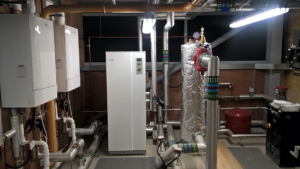August 24, 2020, by sustainablenottingham
Renewable Technology on Campus
This summer, the Estates Development Framework (EDF) was published; its role is to provide direction for future University development and management by setting core goals. The overall theme of the EDF is ‘evolution without a carbon footprint’, and you can read it here.
To support the vision of the EDF, and to support the University’s commitment to the city of Nottingham’s plans to be Carbon Neutral by 2028, we need to reduce our energy footprint and aim to eradicate our direct consumption of fossil fuel. One way in which we can do this is by generating renewable energy on site. We currently generate energy on-site using a variety of renewable technologies, however their contribution to our total energy consumption is only 1%.
On-Site Technologies
At the University of Nottingham, our renewable technologies are used for both electricity generation and to contribute towards heating requirements of buildings. In particular, Jubilee campus was designed holistically with sustainable principles in mind and as such has a diverse mix of on-site generation. Current technologies for on-site energy generation are: photovoltaic panels, biomass boilers, biomass combined heat and power system, and ground, lake and air source heat pumps.

Photovoltaic panels on Cripps Health Centre.
Photovoltaic (PV) panels are installed on many buildings across our UK campuses. They work by converting sunlight into electricity for equipment or lighting. Whilst they can generate a surprising amount of electricity even on a cloudy day, their potential is very much limited by day length and thus has a big difference in summer and winter output. The GSK Carbon Neutral Lab is renowned for its sustainable design, including the University’s largest array of PV panels which cover more than 45% of the roof area. Across all our sites there are approximately 6500m2 of PV panels, which helped to contribute over 46% of our on-site generation last year.
Biomass boilers, which can power central heating systems for a building, are fitted in the Bioenergy building on Sutton Bonington and the GSK Carbon Neutral Lab on Jubilee campus. Across our estate last year biomass boilers contributed almost 15% to our overall on-site renewable energy production. The majority of the heat required for the GSK Carbon Neutral Lab building is supplied by a biofuel combined heat and power (CHP) system; the Energy Technology building also has a biomass CHP system. Overall, CHP systems last year provided 18% of on-site energy generation.

Ground Source Heat Pump in Si Yuan building.
Ground, Lake and Air Source Heat Pumps are installed across our campuses. Ground Source Heat Pumps (GSHP) use pipes that are buried underground to extract heat from the ground to help heat radiators or underfloor heating systems. As the ground stays a fairly consistent temperature this can help heat a building throughout the year. GSHPs are used to heat buildings including Engineering and Science Learning Centre, Cripps Health Centre, Aerospace Technology Centre; last year this technology contributed 19 % to our overall renewable generation. On Jubilee campus several buildings make use of Lake Source Heat Pumps: these work similarly to GSHPs but extract heat from a body of water – in this case the lakes at Jubilee. The Institute for Mental Health building also has an Air Source Heat Pump which absorbs heat from the outside air in order to help heat the building.
Issues with the Current Situation
Whilst these technologies are a start to reducing our carbon footprint, they clearly aren’t sufficient. There are currently feasibility studies being carried out for a 2MW solar PV array at Sutton Bonington which would meet a large amount of our energy needs for the campus. However, we will not reach carbon neutrality purely by expanding the portfolio of our renewable technologies. We must reduce our overall energy consumption on campus.
Moving Forward
As a university community, we can reduce our energy consumption through behaviour change and less energy intensive technologies. Use our checklists to ensure that you are ticking the simple boxes for reducing your energy footprint. Then we must go further, finding innovative changes. Examples could be more flexible working hours, spreading the demand of energy over longer periods to avoid high demand peaks, or changing the way that we operate energy intensive equipment– we are still seeking innovative solutions. We will continue to expand our portfolio of renewables, but this must be done in tandem with a reduction in consumption.
No comments yet, fill out a comment to be the first

Leave a Reply